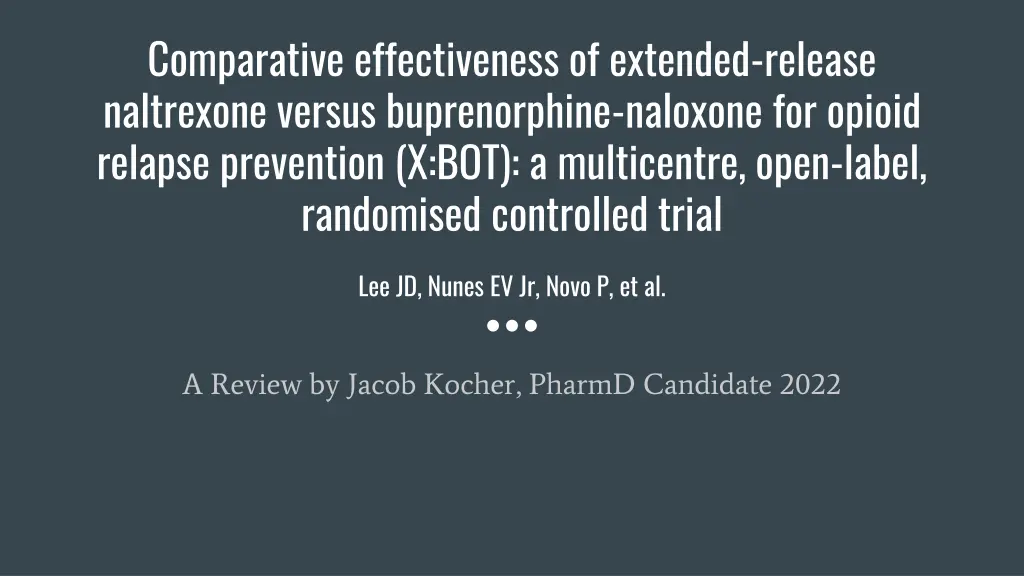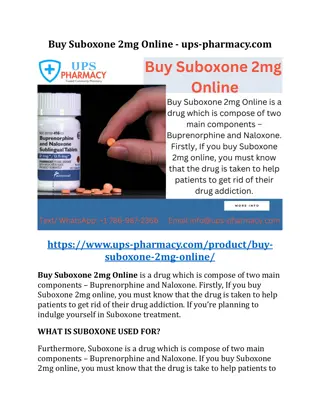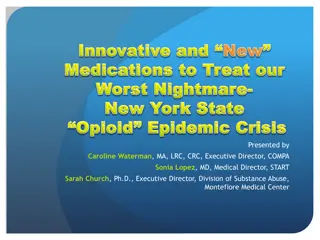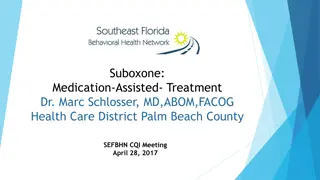
Comparative Effectiveness of Naltrexone vs. Buprenorphine-Naloxone for Opioid Relapse Prevention Study
This study compares the effectiveness of extended-release naltrexone versus buprenorphine-naloxone for opioid relapse prevention. It explores the impact of these treatments on opioid addiction, treatment outcomes, and potential future therapy implications in addressing the opioid abuse crisis. The study involved 570 participants and aimed to determine the benefits of these medications in treating opioid addiction, focusing on opioid relapse-free survival and other key endpoints. Funding and conflicts of interest among study authors are disclosed, providing transparency. Opioid abuse is a significant public health concern, leading to thousands of deaths annually and substantial economic burdens on society. By evaluating different treatment options and their outcomes, this study contributes valuable insights to the field of addiction medicine.
Uploaded on | 0 Views
Download Presentation

Please find below an Image/Link to download the presentation.
The content on the website is provided AS IS for your information and personal use only. It may not be sold, licensed, or shared on other websites without obtaining consent from the author. If you encounter any issues during the download, it is possible that the publisher has removed the file from their server.
You are allowed to download the files provided on this website for personal or commercial use, subject to the condition that they are used lawfully. All files are the property of their respective owners.
The content on the website is provided AS IS for your information and personal use only. It may not be sold, licensed, or shared on other websites without obtaining consent from the author.
E N D
Presentation Transcript
Comparative effectiveness of extended-release naltrexone versus buprenorphine-naloxone for opioid relapse prevention (X:BOT): a multicentre, open-label, randomised controlled trial Lee JD, Nunes EV Jr, Novo P, et al. A Review by Jacob Kocher, PharmD Candidate 2022
Objectives Brief review of opioid addiction and treatment Summarize the study design, objectives, and results Analyze study and results Provide commentary on study s impact for future therapy
Opioid Abuse Almost 50,000 deaths in 2019 were attributed to opioid-involved overdose The US loses an estimated $78.5 billion per year due to opioid misuse per the CDC. This includes the costs of healthcare, lost productivity, addiction treatment, and criminal justice involvement CDC/NCHS, National Vital Statistics System, Mortality. CDC WONDER, Atlanta, GA: US Department of Health and Human Services, CDC; 2019. https://wonder.cdc.gov. Florence CS, Zhou C, Luo F, Xu L. The Economic Burden of Prescription Opioid Overdose, Abuse, and Dependence in the United States, 2013. Med Care. 2016;54(10):901-906. doi:10.1097/MLR.0000000000000625.
Treatment Options Buprenorphine, naltrexone, buprenorphine-naloxone, methadone Clonidine or Lucemyra for withdrawal symptom management Behavioral therapy
Study Objective Determine if IM naltrexone or SL buprenorphine-naloxone showed a benefit in treatment of opioid addiction Primary endpoint: opioid relapse-free survival during 24 weeks of outpatient treatment Relapse defined as 4 consecutive weeks of non-study opioid use by urine toxicology or self-report, or 7 consecutive days of self-reported use Secondary endpoint: failure to initiate medication, opioid use during treatment, and adverse events including overdoses
Funding and Conflicts of Interest of Study Authors Funding received from NIDA (National Institute of Drug Abuse) Several authors had received research support from Alkermes (pharmaceutical company producing Vivitrol) Indivior (maker-of) donated Suboxone for this study and only had access to safety data
Study Design 570 participants were recruited after admission to an opioid addiction treatment program at one of eight community-based inpatient services between 1/30/14 and 5/25/16 24 week, open-label, randomized (at 1:1) trial comparing use of once monthly IM naltrexone to daily Suboxone administration Detoxification protocols were not standardized across locations No opioids (clonidine, comfort meds) at two sites, 3-5 day methadone taper at four sites, 3-14 day buprenorphine taper at two sites Patients were assessed weekly during the study and at 28 and 36 weeks to determine outcomes
Study Population ~75% white, ~70% men, aged 25 45 years, ~80% had a primary heroin use disorder, 63.5% were using by injection, 66% were single, 62% unemployed, and a majority were Medicaid-insured Inclusion Criteria 18 years or older, spoke English, DSM-5 opioid use disorder, and had used non-prescribed opioids in the past 30 days Exclusion Criteria Patients that had other serious medical, psychiatric, or substance use disorders; transaminase concentrations >5 times the upper limit of normal; were suicidal or homicidal; had allergy or sensitivity to [the study medications]; had methadone maintenance treatment ( 30 mg/day); had chronic pain requiring opioids; had a legal status precluding study completion; and were not able to have safe intramuscular IM naltrexone treatment Women that were pregnant, breastfeeding, planning conception, or unwilling to use birth control
Statistical Analysis Results were analyzed using intention-to-treat population and also a per-protocol population Unadjusted Kaplan-Meier survival curves and the extended Cox model hazard ratios compared relapse by group Chi-squared and logistic regression were used for analyses of dichotomous secondary outcomes, Cox models for time-to-event secondary outcomes, and Wilcoxon rank-sum tests and mixed effects models for continuous outcomes
Results 369 (65%) completed Week 28 follow-up. 430 (75%) participants completed Week 36 follow-up More patients were successfully inducted in the Suboxone arm than the Vivitrol (94% vs 72%; 270 vs 204; p<0.001) Vivitrol induction was more successful in the late randomization group than the early (84% vs 53%). However, this ranged greatly by study site (greater retained at extended-stay, opioid-free than a short-stay, methadone taper). Of those inducted, 47% of the Vivitrol and 43% of the Suboxone patients complete all 24 weeks of therapy
Results Primary Outcome: Intention to Treat population: 65% of XR-NTX and 57% of BUP-NX saw opioid relapse (p<0.036) Average time to relapse in weeks was 8.4 for XR-NTX and 14.4 for BUP-NX The constancy of the relative hazard assumption was violated (p=0.005). Risk of relapse was lower in the Suboxone group initially, but this risk was not sustained. Per-protocol group: 52% of XR-NTX and 56% of BUP-NX saw opioid relapse (p<0.44) Secondary Outcomes: Adverse events did not differ significantly between groups, except for injection site reaction with Vivitrol 23 patients experienced 28 overdose events 64% of events in Vivitrol patients, 36% in Suboxone
Authors Conclusions The authors noted that it was more difficult to initiate Vivitrol than Suboxone. However, once started, both medications were equally efficacious and safe. Strengths Recruitment from inpatient detox units rather than outpatient Showed truth of early drop out rates Limitations Low retention in patients Variable induction protocols
Student Analysis Strengths Limitations Demonstrated challenges of initiating addiction treatment Provided a good platform to compare current addiction treatments Procedures were not standardized across treatment centers The constancy of the relative hazard assumption was violated for the intention-to-treat group in the primary outcome
Related Studies Tanum L, Solli KK, Latif ZE, Benth J , Opheim A, Sharma-Haase K, Krajci P, Kun e N. Effectiveness of Injectable Extended-Release Naltrexone vs Daily Buprenorphine-Naloxone for Opioid Dependence: A Randomized Clinical Noninferiority Trial. JAMA Psychiatry. 2017 Dec 1;74(12):1197-1205. doi: 10.1001/jamapsychiatry.2017.3206. Erratum in: JAMA Psychiatry. 2018 Mar 14;75(5):530. PMID: 29049469; PMCID: PMC6583381. Showed (in a smaller sample) that both treatments were equally effective in patient retention and prevention of relapse. Lee JD, Friedmann PD, Kinlock TW, Nunes EV, Boney TY, Hoskinson RA Jr, Wilson D, McDonald R, Rotrosen J, Gourevitch MN, Gordon M, Fishman M, Chen DT, Bonnie RJ, Cornish JW, Murphy SM, O'Brien CP. Extended-Release Naltrexone to Prevent Opioid Relapse in Criminal Justice Offenders. N Engl J Med. 2016 Mar 31;374(13):1232-42. doi: 10.1056/NEJMoa1505409. PMID: 27028913; PMCID: PMC5454800. Examined relapse rates of patients in the criminal justice system treated with naloxone vs counseling and referral. Showed increased time to relapse in naloxone patients.
Conclusion Overall, this study demonstrates the ability of two separate regimens to treat opioid addictions and highlights some of the challenges in maintaining those regimens. Results of this study are not strong enough to alter current recommendations for therapy.
Citations Lee JD, Nunes EV Jr, Novo P, Bachrach K, Bailey GL, Bhatt S, Farkas S, Fishman M, Gauthier P, Hodgkins CC, King J, Lindblad R, Liu D, Matthews AG, May J, Peavy KM, Ross S, Salazar D, Schkolnik P, Shmueli-Blumberg D, Stablein D, Subramaniam G, Rotrosen J. Comparative effectiveness of extended-release naltrexone versus buprenorphine-naloxone for opioid relapse prevention (X:BOT): a multicentre, open-label, randomised controlled trial. Lancet. 2018 Jan 27;391(10118):309-318. doi: 10.1016/S0140-6736(17)32812-X. Epub 2017 Nov 14. PMID: 29150198; PMCID: PMC5806119. CDC/NCHS, National Vital Statistics System, Mortality. CDC WONDER, Atlanta, GA: US Department of Health and Human Services, CDC; 2019. https://wonder.cdc.gov. Florence CS, Zhou C, Luo F, Xu L. The Economic Burden of Prescription Opioid Overdose, Abuse, and Dependence in the United States, 2013. Med Care. 2016;54(10):901-906. doi:10.1097/MLR.0000000000000625. Tanum L, Solli KK, Latif ZE, Benth J , Opheim A, Sharma-Haase K, Krajci P, Kun e N. Effectiveness of Injectable Extended-Release Naltrexone vs Daily Buprenorphine-Naloxone for Opioid Dependence: A Randomized Clinical Noninferiority Trial. JAMA Psychiatry. 2017 Dec 1;74(12):1197-1205. doi: 10.1001/jamapsychiatry.2017.3206. Erratum in: JAMA Psychiatry. 2018 Mar 14;75(5):530. PMID: 29049469; PMCID: PMC6583381. Lee JD, Friedmann PD, Kinlock TW, Nunes EV, Boney TY, Hoskinson RA Jr, Wilson D, McDonald R, Rotrosen J, Gourevitch MN, Gordon M, Fishman M, Chen DT, Bonnie RJ, Cornish JW, Murphy SM, O'Brien CP. Extended-Release Naltrexone to Prevent Opioid Relapse in Criminal Justice Offenders. N Engl J Med. 2016 Mar 31;374(13):1232-42. doi: 10.1056/NEJMoa1505409. PMID: 27028913; PMCID: PMC5454800.






